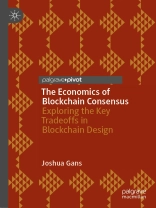Blockchain technologies have been rapidly adopted for the creation of cryptocurrencies and have been explored for a myriad of applications. While this is of important economic interest, the computer science behind how blockchains operate to provide security and provenance has been largely inaccessible to economists. This book is a bridge between the computer science and the economics of blockchains.
The focus is on the value and the achievement of blockchain consensus; that is, how distributed and independent nodes are able to reach an agreement on what the current state of digital ledgers, that are the product of blockchains, are. The book shows that the goals of computer scientists in designing blockchains place very high weight on security beyond what an economist trained in game theory and mechanism design would require. It shows how blockchains can be redesigned to account for key economic trade-offs, and will be of interest to researchers and students of economics, financial technology and computer science, alongside policymakers.
สารบัญ
Chapter 1 Introduction.- Chapter 2: The Value of Blockchain Consensus.- Chapter 3: Security versus timeliness.- Chapter 4: Permissioned versus permissionless.- Chapter 5: Proof of work versus proof of stake.- Chapter 6: Cryptography versus incentives.- Chapter 7: Rules versus mechanisms.
เกี่ยวกับผู้แต่ง
Joshua Gans is a Professor of Strategic Management and holder of the Jeffrey S. Skoll Chair in Technical Innovation and Entrepreneurship at the Rotman School of Management, University of Toronto. He is also chief economist of its Creative Destruction Lab and oversees its blockchain program for startups.












